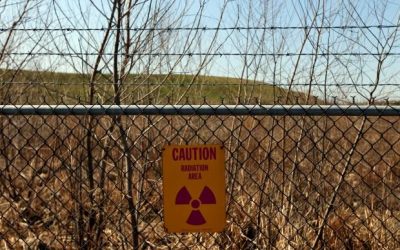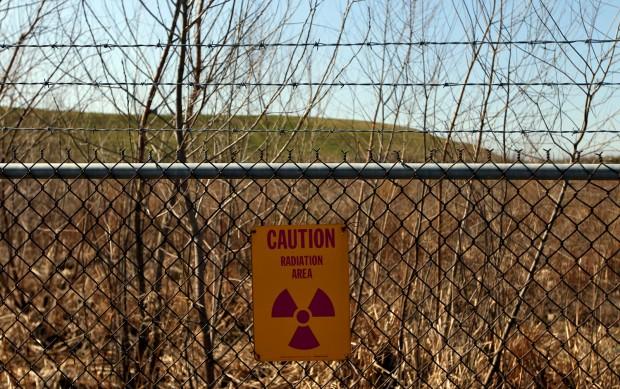
Radioactive sign at the West Lake Landfill
The West Lake municipal landfill in Bridgeton, Missouri is not your ordinary solid waste landfill. By virtue of the highly radiotoxic wastes dumped there, it is a de facto nuclear waste disposal site – a legacy of the U.S. nuclear weapons program (see Figures 1 and 2). Created by illegal dumping in 1973, the waste residues originated from the Mallinckrodt Chemical Works in St. Louis which was involved in U.S. nuclear weapons program from the 1942 to late 1950s. The landfill:
- contains a significant amount of radiotoxic wastes that are not adequately characterized, and that have the potential for mobility of these wastes due to groundwater fluctuation and comingled solvents;
- is in a densely populated area and has no engineered barriers,
- is experiencing the latest of at least two subsurface fires over the past 21 years; and
- is on the alluvial floodplain approximately 1.2 miles from the Missouri River in which the water table recurringly rises and falls by several feet, often within a few feet of the surface.
Even though these concerns were repeatedly raised with the U.S. Environmental Protection Agency (EPA), and despite the extraordinary risks created by subsurface fires, the agency issued a Record of Decision in 2008 which allows for “in place disposal” of these wastes subject to institutional controls with a cap over radiologically contaminated areas. Despite the conclusion reached in 1988 by the U.S. Nuclear regulatory Commission that hazards of the wastes likely warranted removal and isolation, it appears that EPA was inclined toward in-place disposal at least eight years before its decision to do this was formalized.
Of significance is the fact that the largest estimated amount of thorum-230, a long-lived, highly radiotoxic element is present at West Lake – more than any other U.S. nuclear weapons storage or disposal site. Soil concentrations of radium-226 and thorium-230 are substantially greater than uranium mill tailing waste. (See figures 3 and 4). The waste residues generated at the Mallinckrodt site were found to contain the largest concentration of thorium-230 from any single source in the United States and possibly the world. Thorium-230 concentrations were found to be some 25,000 times greater than its natural isotopic abundance.10 With a half-life of 77,500 years, thorium-230 makes up more than 80% of the measured radioactivity in soil at West Lake above cleanup limits set by the Department of Energy (DOE) (see Figure 5). Moreover, as the thorium-230 decays to radium-226, it will increase the radioactivity in the landfill 10 to 100 times over a 9,100 year period.
Given these circumstances, the West Lake landfill would violate all federal legal requirements, established over 30 years ago, for licensing of a radioactive waste disposal site.
Recommendations
Radiation protection of workers who enter on or near areas where radioactive waste was dumped should be mandatory, as they are at Energy Department and commercially licensed radioactive waste sites.
Finally, like other U.S. nuclear weapons legacy sites in the St. Louis, Missouri area, the U.S. Congress should seek to remove these radioactive materials and assure long-term stewardship responsibilities under the Formerly Utilized Sites Remedial Action Program (FUSRAP) managed by the U.S. Army Corps of Engineers and the U.S. Department of Energy.
